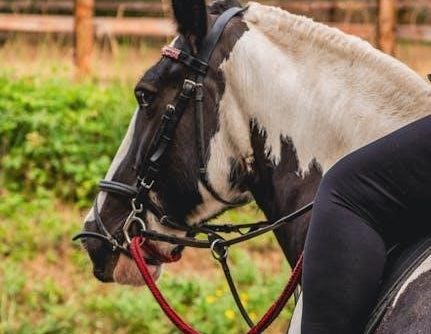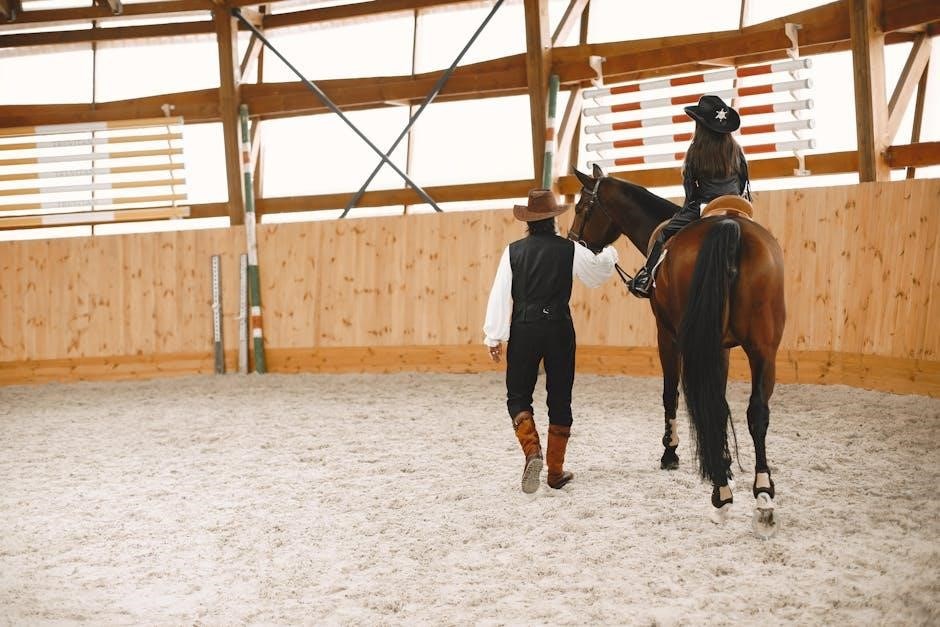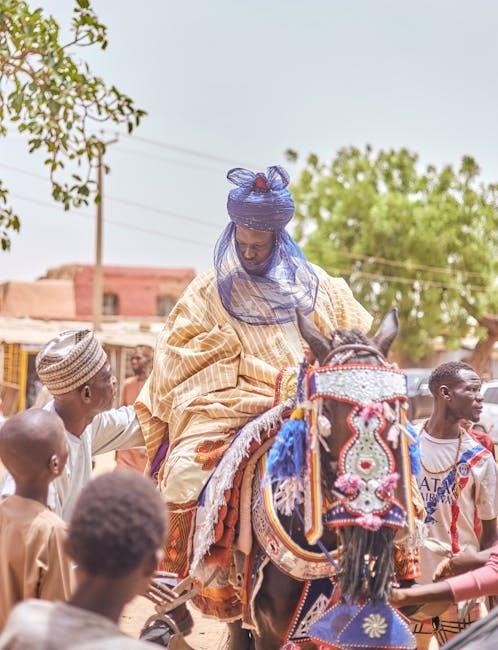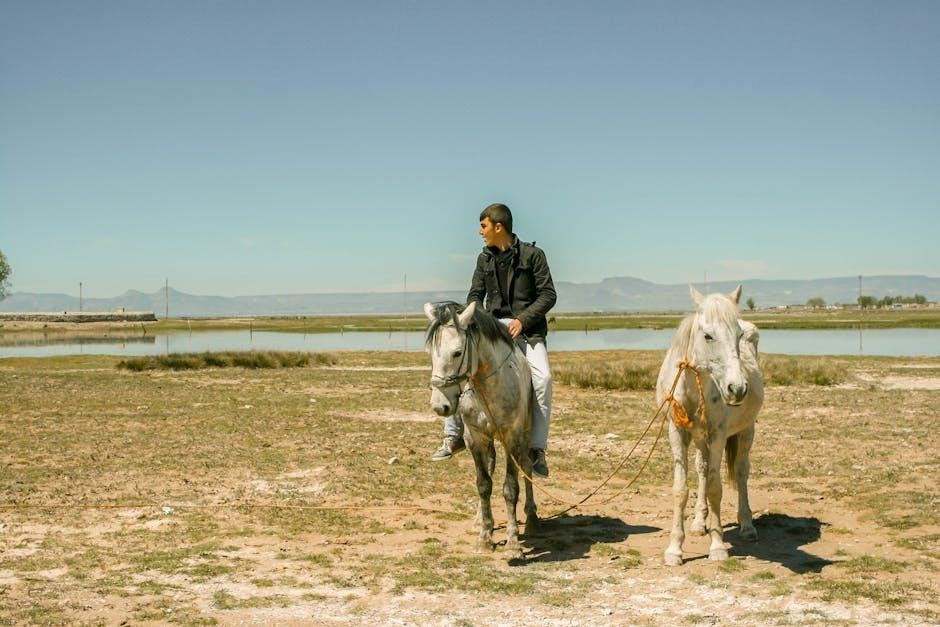
Choosing the right English saddle size is crucial for both rider comfort and horse well-being. This guide covers key measurements, including seat size, flap length, and saddle width, ensuring a proper fit for various riding disciplines and styles.
1.1 Understanding the Importance of Proper Saddle Fit
A properly fitted English saddle is essential for both rider comfort and horse well-being. A saddle that is too small or too large can cause discomfort, restrict movement, and lead to long-term issues for the horse. For the rider, a correct fit ensures security, balance, and optimal performance. Improper fit can result in poor posture, difficulty controlling the horse, and potential safety risks. This section explores why proper fit is critical and how it impacts both parties.
1.2 Overview of English Saddle Components
An English saddle comprises several key components that contribute to its fit and function. The seat size is measured from the pommel to the cantle, typically ranging from 12 to 19 inches. The flaps, which accommodate the rider’s legs, vary in length to suit different disciplines. The gullet, or the space between the two panels, must be wide enough to clear the horse’s spine, ensuring comfort and proper weight distribution. Understanding these elements is vital for selecting the right saddle.
Measuring the Seat Size of an English Saddle
Measuring the seat size involves determining the distance from the pommel to the cantle using a flexible tape measure, ensuring a precise fit for rider and horse comfort.
2.1 How to Measure the Seat Size Accurately
To measure the seat size accurately, place the saddle on a level surface. Locate the nail heads or brads on either side of the pommel. Using a flexible tape measure, span the distance from one brad to the other, passing over the saddle’s center. Ensure the tape lies flat and smooth. The measurement, typically ranging from 12 to 19 inches, determines the seat size. This step is critical for ensuring proper fit and comfort for both rider and horse.
2.2 Seat Size Chart: Standard Measurements
Standard English saddle seat sizes typically range from 12 to 19 inches, increasing in half-inch increments. A 16-inch seat is common for smaller riders, while 18-19 inches suit taller riders. Refer to a seat size chart to match your measurements. Proper fit ensures comfort and balance, with the rider’s knees slightly bent and feet in stirrups; Use this chart to guide your selection for optimal riding performance and horse comfort.

Determining the Flap Length
Flap length impacts rider comfort and position, ensuring proper leg placement and support. It varies by discipline, with longer flaps for jumping and shorter for dressage.
3.1 How Flap Length Affects Rider Comfort
Flap length significantly impacts rider comfort and performance. A properly fitted flap ensures optimal leg support and prevents chafing, allowing for smooth movement. Longer flaps provide additional security for jumpers, while shorter flaps suit dressage riders needing closer contact. Correct flap length aligns with stirrup placement, ensuring a balanced position. A well-fitted flap enhances control, confidence, and overall riding experience, making it essential for discipline-specific needs and personal preference.
3.2 Measuring Flap Length for the Perfect Fit
To measure flap length accurately, place the saddle on a rigid surface and locate the top of the flap. Use a flexible measuring tape to measure from this point to the flap’s end. Ensure the stirrup bars are positioned correctly for an accurate reading. Proper flap length aligns with the rider’s leg length, providing comfort and optimal performance. Incorrect measurements can lead to discomfort or restricted movement, making precise measurement crucial for a perfect fit.

Saddle Width and Gullet Size
Saddle width and gullet size are critical for ensuring proper weight distribution and horse comfort. Measure the width across the tree points and refer to size charts for accuracy.
4.1 Understanding Saddle Width and Its Impact on the Horse
The saddle width plays a vital role in ensuring proper fit and comfort for the horse. A saddle that is too narrow may cause pressure points, leading to discomfort or even injury, while one that is too wide can shift and lose stability. Proper saddle width distributes the rider’s weight evenly across the horse’s back, promoting freedom of movement and preventing muscle strain. Measuring the horse’s back and comparing it to the saddle’s tree width ensures optimal fit and supports the horse’s overall well-being. Regular assessments are essential as horses’ physiques can change over time.
4.2 Gullet Size Chart: Finding the Right Fit for Your Horse
A gullet size chart is essential for determining the correct clearance between the saddle and the horse’s spine. Proper gullet size ensures the saddle sits comfortably without restricting movement or causing pressure. Narrow or wide gullets are matched to the horse’s conformation, with sizes ranging from 6 to 8 inches. Using a gullet size chart helps prevent ill-fitting saddles, ensuring both comfort and performance for the horse; Regular adjustments may be needed as the horse matures or changes shape over time.
Types of English Saddles and Their Size Requirements
Different English saddle types, such as dressage and jumping saddles, have unique size requirements based on riding discipline and style. This guide explains the specific sizing needs for each type.
5.1 Dressage Saddles: Specific Size Considerations
Dressage saddles are designed for precision and comfort, requiring specific size considerations. The seat size typically ranges from 17 to 18.5 inches, with a deeper seat for support. Flap length varies to accommodate rider leg length, ensuring proper contact. The saddle’s width must fit the horse’s back, while the gullet size ensures spinal clearance. Dressage saddles prioritize a snug fit for both rider and horse, enhancing communication and movement fluidity during performances.
5.2 Jumping Saddles: Size and Fit for Optimal Performance
Jumping saddles prioritize mobility and support, with seat sizes ranging from 16 to 18 inches for optimal balance. Flap length is shorter to accommodate shorter stirrups, while the saddle’s forward-cut design allows freedom of movement. Saddle width and gullet size must ensure proper clearance for the horse’s spine, especially during high-impact jumps. A well-fitted jumping saddle enhances both rider stability and horse comfort, crucial for peak performance in demanding disciplines like show jumping.
Using a Saddle Size Chart
A saddle size chart helps riders understand measurements, ensuring proper fit for both rider and horse. It guides accurate sizing, enhancing comfort and performance.
6.1 How to Read and Interpret Saddle Size Charts
Reading a saddle size chart involves understanding measurements for seat size, flap length, and gullet width. Match your measurements to the chart to find the ideal fit. Seat size is measured from the pommel to the cantle, while flap length is determined by rider height and leg length. Gullet width ensures proper clearance for the horse’s spine. By aligning these dimensions, riders can ensure a comfortable and functional fit for both themselves and their horse.
6.2 Common Saddle Size Charts for English Saddles
English saddle size charts typically include measurements for seat size, flap length, and gullet width. Seat sizes range from 12 to 19 inches, measured from the pommel to the cantle. Flap lengths vary based on rider height and leg length, while gullet sizes ensure proper horse comfort. Standard charts often categorize saddles by discipline, such as dressage or jumping, to meet specific rider needs. Using these charts helps riders and fitters select a saddle that ensures optimal comfort and performance for both rider and horse.
Rider Comfort and Saddle Fit
Rider comfort and saddle fit are essential for optimal performance and enjoyment. A well-fitted saddle ensures proper support, balance, and freedom of movement, preventing discomfort and pain.
7.1 Ensuring the Rider Feels Secure and Comfortable
A properly fitted saddle ensures the rider feels secure and comfortable. The seat size should allow the rider to sit with a slight gap at the front and back, while the flap length supports the leg without restriction. The saddle’s balance and even weight distribution prevent pressure points, keeping the rider relaxed and in control. A secure fit enhances confidence and stability, allowing for optimal communication with the horse.
Key factors include proper seat depth, cushioning, and a clear path for the rider’s legs. Ensuring the saddle isn’t too tight or too loose guarantees freedom of movement and long-term comfort.
7.2 How Saddle Size Affects the Rider’s Position
The saddle size significantly impacts the rider’s position by influencing balance, posture, and control. A correctly sized saddle ensures the rider’s weight is evenly distributed, allowing for a secure and balanced seat. If the saddle is too small, it can cause discomfort and restrict movement, while a saddle that’s too large may lead to a lack of stability. Proper fit enables the rider to maintain optimal posture, communicate effectively with the horse, and perform confidently in their discipline.
Accurate sizing ensures the rider’s legs are positioned correctly, avoiding strain or restricted movement, which is essential for precise control and overall riding performance.

The Role of Riding Discipline in Saddle Size Selection
Different riding disciplines require specific saddle sizes and features. Dressage, jumping, and other styles demand unique fits to ensure optimal performance, comfort, and support for both rider and horse.
8.1 How Different Disciplines Influence Saddle Size Needs
Different riding disciplines have unique demands, influencing saddle size and fit. For example, dressage requires a deeper seat for support and longer flaps for stability, while jumping saddles prioritize a shorter flap for freedom of movement. Each discipline’s specific needs dictate variations in seat size, flap length, and overall saddle design to ensure optimal performance, rider comfort, and proper horse support.
8.2 Saddle Size Recommendations Based on Riding Style
Riding style significantly impacts saddle size needs, as it influences both rider comfort and performance. Competitive riders may require a snug, precise fit for control, while endurance riders benefit from a slightly larger seat size for comfort over long distances. Casual riders often prefer versatile saddles that accommodate various riding positions. The saddle’s design should align with the rider’s position, ensuring freedom of movement and proper support, while also maintaining optimal fit for the horse.

Measuring Your Horse for an English Saddle
Measuring your horse accurately ensures proper saddle fit, focusing on the horse’s back length, shoulder angle, and ribcage shape to determine the ideal saddle width and style.
9.1 Step-by-Step Guide to Measuring Your Horse
To measure your horse for an English saddle, start by assessing the length of the horse’s back from the withers to the last rib. Next, measure the shoulder angle to determine saddle flap length. Use a flexible measuring tape to evaluate the ribcage circumference and back shape. Ensure the horse stands naturally, with weight evenly distributed on all four legs. These measurements help identify the ideal saddle width and style for optimal comfort and fit.
9.2 Tips for Accurate Horse Measurements
For precise measurements, ensure your horse stands naturally with even weight distribution. Use a flexible measuring tape to assess the back and ribcage. Measure multiple times to confirm accuracy. Consider the horse’s muscle tone and breed-specific traits. Consistency is key; always measure in the same spot. If unsure, consult a professional fitter to ensure the best fit for both horse and saddle, avoiding discomfort or imbalance during riding.
Common Mistakes to Avoid When Sizing an English Saddle
Common errors include incorrect seat size, flap length, and saddle width measurements; Inconsistent techniques and ignoring gullet size can lead to poor fit, affecting rider comfort and horse performance.
10.1 Mistakes in Measuring Seat Size and Flap Length
Incorrectly measuring seat size by not aligning the tape with the nail heads or cantle center leads to poor fit. Similarly, flap length errors occur when not measuring from the top of the saddle to the stirrup bar, causing discomfort and improper leg positioning. These mistakes can result in a saddle that doesn’t support the rider or horse effectively, leading to discomfort and performance issues.
10.2 Avoiding Errors in Saddle Width and Gullet Size
Incorrectly measuring saddle width and gullet size can lead to poor fit and discomfort for the horse. Using a template or gauge ensures accurate width assessment. The gullet must align with the horse’s spine, avoiding pressure points. Double-checking measurements prevents errors, ensuring proper clearance and support. Accurate fitting prevents long-term issues for both horse and rider, ensuring optimal performance and comfort in all disciplines.
Proper saddle fit is essential for both rider comfort and horse well-being. Accurate measurements ensure optimal performance and long-term health for both, making careful selection crucial.
11.1 Final Tips for Choosing the Right English Saddle Size
When selecting an English saddle, prioritize proper fit for both rider and horse. Ensure the seat size accommodates your leg length comfortably, and the flap length supports your riding style. Consider the horse’s back shape and width to avoid pressure points. Use a saddle size chart as a guide, but always test the saddle in person. A well-fitting saddle enhances performance, comfort, and the overall riding experience.
11.2 The Importance of Proper Fit for Both Rider and Horse
A proper-fitting English saddle is essential for both rider comfort and horse well-being. A saddle that fits correctly ensures the horse’s back remains free from pressure points, preventing discomfort or long-term health issues. For the rider, it provides security and balance, allowing for effective communication with the horse. A well-fitting saddle enhances performance and overall riding experience, making it a critical investment for any equestrian. Always prioritize accurate measurements and professional guidance to achieve the best fit.